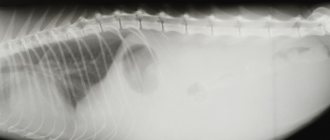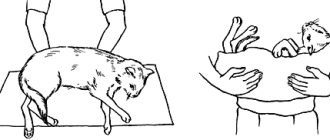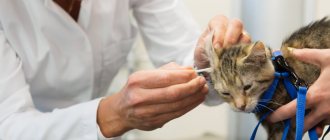Many wild and domestic cats are carriers of an enteritis pathogen (coronavirus), which does not cause any clinical signs in them.
It does not pose a threat to humans and other animal species and rarely leads to the death of a four-legged pet.
However, a mutation of the virus causes a secondary disease, feline infectious peritonitis (FIP), which is fatal. Why the disease affects certain animals is unknown.
Young and elderly individuals (over 10 years old) are especially susceptible to the pathogen.
The disease is common in places where four-legged animals are crowded (shelters, exhibitions, pet stores, nurseries).
Infection occurs through prolonged contact of a healthy mammal with the secretions of a patient.
Ways of spread of infection
The source of the pathogen is infected and recovered individuals (carriers). A sick cat, starting from the second half of the incubation period and for several months after recovery, is a reservoir of infection and is dangerous for other relatives.
The pathogen is released into the environment:
- with feces and urine
- found in nasal discharge
The main route of infection is oral, but airborne droplets cannot be ruled out. A weakened immune system plays a major role in the development of the disease.
Misconceptions and facts
Given the lack of knowledge, many misconceptions have formed among pet owners regarding this pathology.
Table 2. Common misconceptions
| Misconception | Refutation |
| FIP and coronavirus are identical diseases | No. The name of all coronavirus strains is FECV. When mutated into the variant that causes infectious peritonitis, it becomes FIPV. The term FIP refers to the name of this disease. |
| FIP is transmitted through contact with an infected animal | The transformation of coronavirus is individual for each animal. Cats do not become infected with FIP, but produce it themselves based on the FECV mutation. |
| Infected animals must be isolated | Infected individuals are not dangerous to other pets. |
| The disease can be determined by antibody titers | This indicator is not decisive in diagnosing the disease. |
| Animals with FIP always have distended peritoneum | Pathology occurs in wet and dry varieties. In the first case, swelling may appear in the abdominal area, as well as in the sternum area. |
| FIP is a hereditary disorder | No, FIP is not a genetic disease. A pet may only have a predisposition to its occurrence due to the state of the immune system. |
| The disease can be prevented by vaccination | No, scientists have not yet achieved success in creating a vaccine. |
| After the death of an infected animal, the premises become dangerous for a new pet | No, the infection is unstable outside the host. According to recent studies, the virus can remain active on dry surfaces for 7 weeks, but it does not take root in another organism. |
Infected individuals are not dangerous to other pets
Why is infectious peritonitis dangerous?
The virus has a pathological effect on small blood vessels, disrupting the nutrition of all body tissues.
They suffer from this:
- organs of vision
- brain and spinal cord
- heart, lungs, liver, pancreas, kidneys, intestines
- The lymph nodes
The disease progresses slowly, and the first symptoms may appear many weeks after infection. Unfortunately, viral peritonitis cannot be treated; most sick animals have to be euthanized.
FIP is the cause of pregnancy pathologies:
- infertility (birth of one or two kittens)
- repeated abortions
- intrauterine resorption and fetal development abnormalities
- stillbirth
Cats that produce re-infected kittens should be isolated and carefully examined.
Classification according to the form of the disease
The disease manifests itself in two main forms - effusion and dry. In both cases, the abdominal organs are affected, less often the chest is involved.
Exudative FIP in cats occurs rapidly, with high fever. Fluid accumulates in the peritoneal cavity, and the abdomen increases significantly in size. If the pleural cavity is affected, breathing and heart function are impaired. This form is easier to recognize, but difficult to manage with treatment.
The dry form of the disease is more difficult to diagnose. With it, small foci of inflammation appear on the surface of the intestine, peritoneum, and less commonly, the pleura and pericardium, which turn into dense nodules. There are no noticeable external changes in the pet, but the condition is gradually worsening.
How does the disease manifest itself?
The interval from the moment of infection to the appearance of signs of the disease ranges from 2-3 weeks to several months. In most cats it occurs in a hidden (latent) form.
The course and severity of clinical symptoms depend on the age of the pet (small animals get sick more often and more severely), the presence of immunity (with previous vaccinations, resistance is higher), the amount and virulence of the virus, as well as genetic predisposition to the disease.
Wet form of viral peritonitis (exudative)
Early manifestations are not specific and are similar to other cat diseases.
At the same time they observe:
- lack of appetite
- weight loss
- apathy
- depressive state
As the amount of fluid in the abdominal or chest cavity increases, other symptoms appear.
- high temperature (40˚C and above)
- pale skin
- labored breathing
- rapid pulse
- fast fatiguability
- vomit
- diarrhea
- liver damage (dark urine, yellow skin)
- signs of peritonitis (tense, swollen abdomen against a background of general exhaustion)
The animal begins to experience shortness of breath, wheezing and murmurs in the heart/lungs. Pericarditis due to the presence of fluid in the pericardial sac can cause the sudden death of a pet.
Dry form of FIP (disseminated)
At the initial stage, the symptoms are the same as with the wet form, only there is no leakage of fluid into the body cavities. In 25% of cases, the disease develops against the background of feline viral leukemia.
The infection is accompanied by pathologies:
- eye (conjunctivitis, damage to the iris and retina)
- kidneys (signs of glomerulonephritis)
- liver (yellowness of the skin, soreness and enlargement of the borders)
- lungs (catarrhal bronchopneumonia)
- pancreas (pancreatitis)
- Central nervous system (circular movement, paresis of limbs, skin sensitivity)
Cats that have recovered from illness become hidden virus carriers and are dangerous to healthy individuals.
FIP in cats
FIP is a disease that affects the immune system of cats. In the scientific literature it may be called infectious peritonitis.
After the discovery of this pathology in the early 60s of the last century, experts believed that its development was provoked by coronavirus. It is present in cats in an inactive form and can mutate into FIP. However, in the light of recent research, immunologists refute this opinion. According to recent discoveries, coronavirus does not affect the occurrence of FIP.
Coronavirus is the most dangerous infection in cats
An alternative theory suggests that there are several strains of the virus, and only one of them transforms into FIP. However, methods for isolating genetically homogeneous viral progeny have not yet been developed. Laboratory tests make it possible to see the quantitative expression of the coronavirus. There are no tests that detect FIP.
In Russia, the disease appeared in the mid-90s of the last century, coinciding with the mass breeding of cats. 10-month-old kittens are most susceptible to pathology. Based on these statistics, experts say that immunity to FIP is determined by the age of the pet. Many strains of coronavirus are harmless, and animals remain healthy throughout their lives.
About 30% of cats are infected with one or more strains of coronavirus and only 1% with infectious peritonitis.
The development of FIP is like a ticking time bomb
Why is FIP dangerous?
FIP is a consequence of a mutation in the enteric virus FECV. Despite the fact that the diseases are similar in biological qualities, they are radically opposite in the degree of pathogenicity. The infection that causes enteritis damages the cells of the intestinal epithelium, and FIP, such as AIDS, affects the cells of the immune system. As a result, inflammatory processes of various systems develop, leading to death.
Pets aged from six months to 2 years are at risk
Etiopathogenesis of the disease
The cause of infection is a poor state of immunity, which affects the susceptibility of animals to the disease. If the pet’s body gives a decent immune response, the activation of the virus in macrophages stops. If it penetrates the cellular defenses, the pet becomes infected.
Infection process
Microphages are cells of the immune system whose activity is aimed at combating infectious agents. During normal functioning of the body, they capture and digest harmful microorganisms. In case of immune failures, they are not able to neutralize the virus.
Taking into account the specific mechanism of the infection’s effect on the body, scientists concluded that it is not the virus that kills the cat, but the antibodies.
It is not the virus that causes death, but the defective antibodies produced
Why does coronavirus mutate into FIP?
The factors that provoke the mutation have not been studied. Scientists were only able to find out the reasons that increase the risk of coronavirus modification in FIP:
- Stress. Too much crowding or moving to a new home causes discomfort in animals.
- Age. Older and younger cats are more susceptible to the disease. At risk are pets aged from 6 months to 6 years and after 11 years.
- Weakened immunity. Since FIP belongs to the category of immune pathologies, a decrease in the body’s protective functions increases the chances of mutation.
Possible predisposition to FIP
Types of FIP
Table 1. Types of FIP
| Wet | Dry |
| It is considered an acute type of pathology. Serious damage to blood vessels occurs, accompanied by protein leakage. The process manifests itself as the release of transudate into the abdominal, pericardial or pleural cavities. This form of pathology develops from 2 to 4 months. | Chronic type, which is characterized by the formation of nodules in organs. Occurs in animals with a mature immune system. The severity of the pathology is determined by the part of the body in which the infectious process occurs. Develops slowly, up to 6 months. |
The wet form is most often recorded. Sometimes both types of disease are present at the same time.
Dropsy is one of the symptoms of FIP.
Neonatal peritonitis of kittens
The virus can cause fading of newborn kittens and their sudden death.
The baby is observed:
- weight loss
- weakness
- exhaustion
- general deterioration of condition
- labored breathing
- cyanosis of the skin and mucous membranes
- death within a few hours from circulatory collapse
The infection is especially dangerous for nurseries, where entire litters of kittens die from viral peritonitis. When the first clinical signs appear, you should seek help from a veterinarian as soon as possible.
Diagnostics of ID
A family history and complaints of the child (if he is not a newborn), an examination, as well as a number of laboratory tests are collected: molecular genetics, clinical blood test, etc.
Important! If the family already has a child with primary immune deficiency, then prenatal diagnosis is extremely important when carrying a second one.
Signs and symptoms of primary immunodeficiency are detected in children already in the first weeks of life. When a doctor collects anamnesis, he pays special attention to the frequent incidence of viruses and bacterial infections, to heredity aggravated by disorders of the immune system, to congenital malformations.
Often such pathology is detected much later and by chance, when other tests are performed.
The main methods for diagnosing both congenital and acquired disorders of the immune system:
- examination of the child, during which special attention is paid to the condition of the skin, as there may be fungal infections, erosions, dystrophy, ulcers, swelling of different parts of the body;
- blood tests - pathology is indicated by a violation of the leukocyte formula;
- special immunological studies;
- molecular genetic analysis.
Research on FIP
Diagnosis is based on medical history, existing clinical symptoms and laboratory results (blood, free fluid). Analysis of abdominal and thoracic effusions makes it possible to confirm the diagnosis of feline infectious peritonitis.
A biopsy of the affected organs is indicated. Serological tests for the presence of coronavirus are ineffective and can give false positive results.
In case of wet form, the following should be excluded:
- peritonitis due to bacterial infection
- toxoplasmosis
- ascites in pathologies of the heart and kidneys
- malignant neoplasms
- acute heart failure
- trauma to the thoracic and abdominal organs
The dry form is differentiated from:
- lymphosarcoma
- tuberculosis
- parasitic infestations
Viral immunodeficiency (FIV, FIV)
This is an infectious chronic disease of cats with irreversible damage to the immune system and high mortality. The virus is widespread throughout the world due to the lack of specific treatment and developed vaccines.
The main carriers of the infectious disease are adult and elderly cats (over 5 years old). The virus is transmitted through animal bites (saliva, blood), as well as through mutual licking of cats.
Symptoms of the development of viral immunodeficiency are similar to leukemia:
- decreased activity in a sick pet;
- low appetite and weight loss;
- persistent diarrhea;
- inflammatory diseases of the oral cavity;
- neoplasms in the lymphatic system;
- superimposition of secondary infections.
If a sick cat is diagnosed with Viral Immunodeficiency, the pet should be isolated and given symptomatic treatment using immunomodulators. You also need to avoid contact with healthy cats.
Expert opinion
Chepa Natalya Semenovna Veterinarian Ask an expert Infected animals are recommended to be kept at home without walking, castrated, fed with industrial feed to eliminate the risk of contracting infections through raw meat or fish. If your animal is diagnosed with FIV, but its general condition is satisfactory, and the examination did not show any abnormalities, then the pet has every chance of living a long life. It is necessary to take blood tests (clinical and biochemical) and a general urine test once every six months, as well as an abdominal ultrasound and chest x-ray once a year. Sick cats are not recommended to use drugs that suppress the body's immune system, only if there is a confirmed diagnosis requiring such therapy.
Treatment of feline viral peritonitis (FIP)
If a pet’s disease occurs as a second infection, regardless of the form, the animal is doomed and will die within a few weeks (maximum 2 months).
To alleviate suffering and stabilize the general condition, symptomatic treatment is carried out. The use of diuretics, as well as antibacterial and hormonal drugs to suppress secondary infection is indicated.
If exudate accumulates in the abdominal and thoracic cavity, a puncture is performed and the fluid is removed. However, these are all temporary measures; the best solution in this situation is humane euthanasia of the animal.
FIP treatment
Since in most cases the disease is fatal, supportive therapy is used. Symptomatic treatment includes the use of the following groups of medications:
- antiviral drugs;
- antibiotics;
- cardiotonics;
- immunostimulants;
- diuretics;
- corticosteroids;
- potassium-sparing agents;
- vitamins.
In severe cases, blood transfusions are prescribed.
If there is a large accumulation of fluid, the doctor makes a puncture
If fluid accumulates in the abdomen or sternum, the veterinarian will begin to drain it. This measure brings only temporary relief to the animal, since the transudate is collected again. In this case, beneficial elements are washed out of the body, especially potassium. As a result, the more often excess fluid is removed, the more harm is caused to the body.
Coronavirus that has not yet mutated into FIP can be treated. When diagnosing infectious peritonitis, the doctor recommends euthanasia.
New trends in treatment
American specialists have achieved success in treating the dry form of FIP. 20% of animals showed an improvement in their physical condition after taking Polyprenyl immunostimulant.
Russian scientists have succeeded in combating the wet form of infectious peritonitis by developing Fosprenil . The heated liquid was injected into the peritoneum after pumping out the transudate. Rectal and oral forms of administration were also used. 2 weeks after taking the drug, progressive remission and stabilization of vital signs were observed. During testing of the drug, 6 animals were completely cured.
Immunomodulator "Fosprenil" - an innovative drug for the treatment of FIP
Prevention of infection
To prevent the occurrence and spread of the disease, you should avoid places with large concentrations of animals, carry out vaccinations in a timely manner and observe sanitary and hygienic standards for keeping mammals.
You should protect your pet from psychological discomfort that reduces the body’s natural resistance, feed it well, treat it in a timely manner against blood-sucking parasites and helminths, and also contact a veterinarian if your pet is unwell.
It is necessary to regularly check the cattery and all cats in the house. Because serological testing is often inaccurate, animals suspected of having FIP are isolated and observed. When a new pet arrives, quarantine is required for 2-3 weeks and testing for the presence of coronavirus.
Vaccination
The FIP vaccine Primucell has been shown to be effective (50-70% effective) in cats over 16 weeks of age. It is not effective for kittens under 16 weeks of age or cats positive for coronavirus. It is also not effective when used on animals coming from breeding facilities with endemic coronavirus, possibly because they are already infected with it. The Primucel FIP vaccine causes the formation of an immune response in cats to the feline peritonitis virus, 4 weeks after a double dose, lasting at least 12 months. The vaccine is harmless and has no medicinal properties.
Kittens are vaccinated from 16 weeks of age twice with an interval of 3 weeks. Subsequent revaccinations of animals are carried out annually with one dose of Primucel FIP vaccine - 0.5 ml. After vaccination, nasal discharge and a slight increase in body temperature may appear for 1-2 days. After administration of the Primucel FIP vaccine, an allergic reaction may develop. In this case, the animals are given appropriate symptomatic therapy. The immune response can be reduced in animals that have been exposed to stress (transportation, regrouping, etc.), are in unfavorable environmental conditions, are not fed properly, and are not following the instructions for using the vaccine.
Cats living in households in groups of 1 to 3, where the expected probability of developing FIP is only about 1/5000, are the group that will develop the best immunity from the Primucell vaccine, but its use in this environment will be quite ineffective in reducing the incidence cases of FIP in the entire cat population. For example, if a vaccine is 50% effective, 10,000 animals would need to be treated with it to save one from the infection. Some cattery owners have experimented with the use of the Primucell FIP vaccine in six-week-old kittens, on the assumption that since kittens at this age lose maternal immunity, they will be able to mount an immune response to coronavirus vaccination, and that by thus preventing coronavirus infection, it will be possible to avoid disease with its mutant form of FIP. To date, such experiments have demonstrated a reduction in the incidence of virus carriage in vaccinated animals, but not a reduction in the mortality of kittens from FIP. It remains to be assessed whether the benefits of vaccination outweigh the risks of vaccinating very young kittens. One of the possible risks is the recombination of coronavirus strains into new, even more virulent ones.
Treatment methods for secondary ID
Immunotropic therapy is mainly used, which can be of different directions:
- active immunization;
- replacement therapy;
- taking immunotropics.
The choice of immunotropic therapy depends on how acute the inflammatory-infectious process is and what immunological defect is identified. When the symptoms of the disease subside, vaccine therapy can be used for prevention.
Immunoglobulins administered intravenously are used as replacement therapy. Their main active ingredient is special antibodies obtained from donors. Immunoglobulins containing only IgG are often prescribed.
Immunotropic treatment of secondary ID
Using immunomodulators, the effectiveness of antimicrobial therapy can be increased. Immunomodulators should be part of complex therapy together with etiotropic treatment of infection. The doctor calculates the regimen and dosage individually.
Immunological monitoring should be carried out while taking immunomodulators. If the infection is in an acute stage, immunomodulators are used with caution. Otherwise, you can cause a severe general inflammatory response and septic shock as a result. Source: G.A. Samsygina, G.S. Koval Problems of diagnosis and treatment of frequently ill children at the present stage // Pediatrics, 2010, v. 89, no. 2, pp. 137-145
Signs of immunodeficiencies
In immunodeficiencies, the main manifestations are severe bacterial, fungal or viral infections. We are not talking about banal colds, but about serious conditions: persistent sinusitis, recurrent pneumonia, multiple abscesses, fungal infections of the skin, mucous membranes and intestines, herpetic rashes. The more severe the stage of immunodeficiency, the more serious the manifestations.
Doctors distinguish five groups of PID depending on the damage to one or another part of the immune system:
- damage to humoral immunity;
- combined;
- phagocytosis defects;
- cellular problems;
- pathology of complement systems.
PID can be suspected based on a set of certain signs, but the diagnosis is confirmed in the laboratory, according to an immunogram, and in the case of HIV, by identifying antibodies to human immunodeficiency. Key features include:
- presence of PID in family members, death from infections at an early age;
- recurrent purulent otitis (more than 8 cases per year), two or more sinusitis;
- two or more pneumonias in a year;
- lack of effect from taking standard antibiotics used for more than 2 months;
- severe complications after vaccination with live vaccines;
- recurrent purulent processes of the skin and soft tissues (boils, abscesses);
- identification of two or more systemic infections with meningitis, sepsis, osteomyelitis;
- recurrent systemic candidiasis in patients older than one year;
- severe atypical infections (for example, Pneumocystis pneumonia).
These phenomena can complement long periods of low-grade fever, repeated infections with the transition to chronic, recurrent forms, ineffectiveness in the treatment of infections according to standard regimens, decreased performance, and constant asthenia. But a full diagnosis with an examination by an immunologist and the study of a detailed immunogram is important. Source: RajeN, DinakarC. OverviewofImmunodeficiencyDisorders // ImmunolAllergyClinNorthAm. 2015 Nov;35(4):599-623. doi: 10.1016/j.iac.2015.07.001. Epub 2015 Aug 25..
Objectives of immunological examinations:
- confirmation of immunodeficiency states;
- determination of the severity of violations of one or another part of the immune system;
- individual selection of immunocorrective therapy and assessment of its effectiveness;
- making a prognosis, monitoring therapy, preventing complications.










